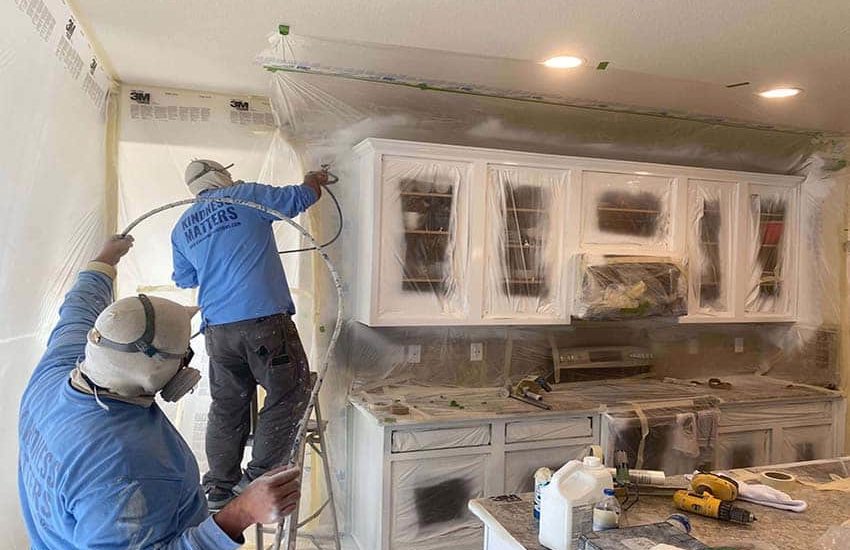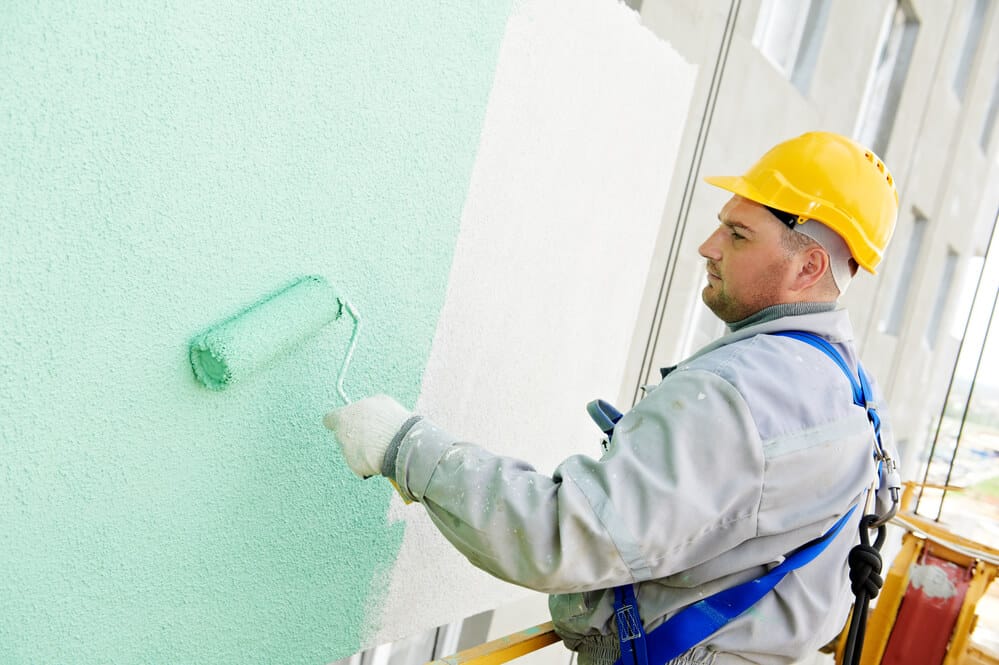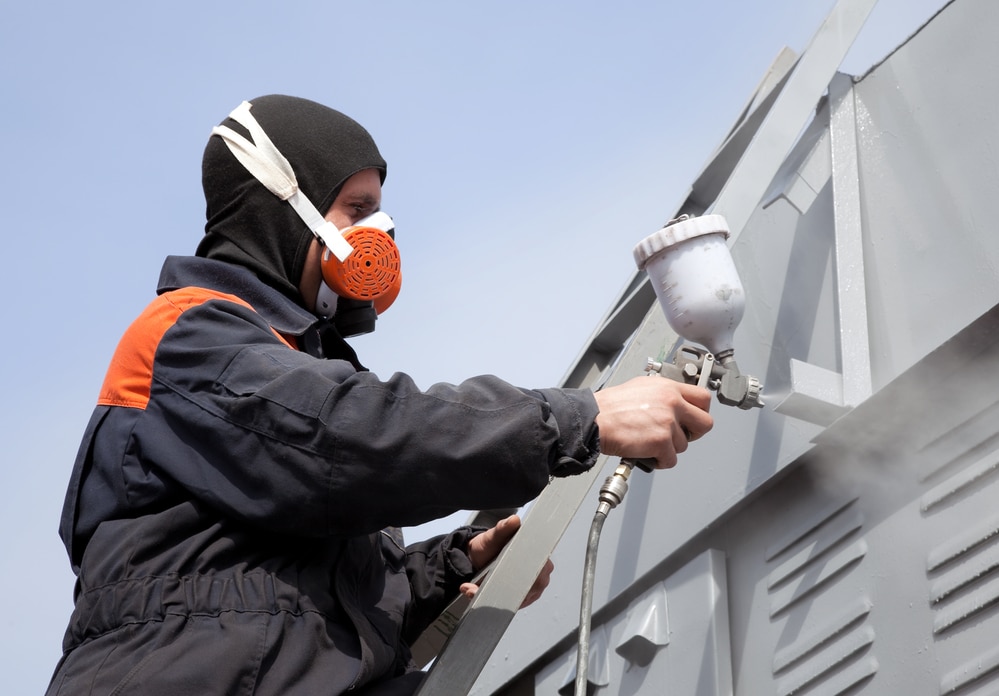
Call Us Today!

Call Us Today!

Selecting the most suitable painting method is a pivotal decision that significantly impacts the outcome of any painting project.
Whether it’s revitalizing the walls of your home, giving new life to furniture, or undertaking a larger-scale endeavor, such as painting the exterior of your house, the method you choose can make all the difference in achieving a flawless finish.
This post will delve into two primary painting methods: the precision of spray painting and the familiarity of using a roller. By delving into the nuances of these methods, we aim to equip you with the knowledge to make an informed choice for your painting endeavors.
Spray painting and painting with a roller are two contrasting approaches, each with its own set of benefits and drawbacks. The former employs the finesse of air-powered application, while the latter relies on the tried-and-true method of manually rolling paint onto surfaces.
As we navigate through this comparison, we will navigate the intricacies of spray paint versus roller, the considerations of a paint sprayer versus a roller, the debate between spray versus roll paint, and the contrasting features of a paint roller versus a sprayer.
By the end, you’ll have a comprehensive understanding of which method aligns best with your specific project requirements, whether it’s about achieving impeccable finesse or efficiently tackling larger surface areas.
In need of help painting your home? Kind Home Solutions is your go-to service for interior and exterior painting in Colorado.
We serve residents in Denver, Westminster, Broomfield, Thornton, Arvada, Lafayette, Golden, Lakewood, Parker, Highlands Ranch, Wheat Ridge, Lone Tree, Littleton , Englewood, Aurora, and Centennial.
Both paint sprayers and paint rollers offer distinct advantages, making them valuable tools for different types of projects.
The choice between the two hinges on factors like the nature of the surface, the desired finish, and the scale of the project at hand.
Paint sprayers are ingenious tools designed to deliver a controlled and even coat of paint onto various surfaces. They operate by transforming liquid paint into a fine mist, which is then propelled onto the target area through the force of compressed air or a high-pressure mechanism.
This mist-like application offers a smooth and uniform finish that’s particularly well-suited for intricate details and irregular surfaces.
Paint sprayers operate on the principle of atomization. The paint is forced through a nozzle, where it’s broken down into tiny droplets. These droplets are then released into the air, forming a mist of paint particles.
The mist is directed onto the surface being painted, creating a thin and even layer of paint. The result is a professional-looking finish with minimal brushstrokes or roller marks.
There are various types of paint sprayers available, each catering to different project needs. Airless paint sprayers utilize high pressure to atomize paint, making them ideal for covering large areas quickly.
HVLP (High Volume Low Pressure) sprayers use a lower pressure, producing less overspray and making them suitable for indoor projects. Additionally, there are handheld and stationary models, each with its own advantages depending on the scope of your project.

Rollers come in various nap lengths and materials, allowing you to achieve different finishes. Short nap rollers are ideal for smooth surfaces, while longer nap rollers are better suited for textured surfaces like stucco or popcorn ceilings. The material of the roller cover, such as foam, polyester, or natural fibers, also influences the texture and coverage of the paint.
Using a roller is straightforward. After dipping the roller cover into the paint tray, the roller is evenly coated with paint. The roller is then applied to the surface in a series of vertical or horizontal strokes, evenly distributing the paint as it goes. The roller’s nap picks up and deposits paint onto the surface, resulting in a consistent and controlled application.
By weighing these advantages and disadvantages, you can determine if spray painting aligns with the demands of your project. While spray painting offers speed, finesse, and versatility, it demands a certain level of expertise and preparation to ensure a successful outcome.
Paint sprayers excel at covering expansive areas quickly. They emit a fine mist of paint that covers surfaces efficiently, reducing the time required for application. This speed is especially beneficial for projects involving large walls, fences, or the exterior of a building.
Paint sprayers produce a remarkably smooth and consistent finish. The mist-like application minimizes visible brushstrokes or roller marks, resulting in a professional look that’s hard to achieve with traditional methods.
Paint sprayers are adept at reaching nooks, crannies, and intricate details that can be challenging for rollers or brushes. This versatility makes them invaluable for projects involving detailed woodwork, furniture, or ornate surfaces.
One of the primary challenges with spray painting is overspray – the mist of paint that can drift beyond the intended surface. Without proper control, overspray can affect nearby objects or surfaces, necessitating careful masking and protection.
Effective spray painting demands meticulous preparation. Surrounding areas must be thoroughly covered or masked to prevent unintended paint deposits. Failing to do so can result in time-consuming cleanup and potential damage to adjacent surfaces.
Mastering the technique of spray painting requires practice. Novice painters may initially struggle with achieving consistent coverage and avoiding uneven application. Learning how to control the sprayer’s distance, angle, and pressure takes time and patience.
As you consider the advantages and drawbacks of painting with a roller, keep in mind that this method offers dependable results for flat surfaces and situations where controlled application is essential. However, it may not be the optimal choice for projects requiring a high level of finesse or when time efficiency is paramount.
 Good Coverage on Flat Surfaces
Good Coverage on Flat SurfacesPaint rollers excel at providing even coverage on flat surfaces, such as walls and ceilings. The rolling action distributes paint consistently, ensuring an even coat without the risk of streaks or uneven application.
Unlike paint sprayers, paint rollers produce minimal overspray. This translates to less wasted paint and a more efficient use of resources, making them an eco-friendly choice.
Paint rollers are user-friendly and require minimal equipment setup. They are an approachable choice for both experienced painters and those new to DIY projects, offering an accessible method for achieving satisfactory results.
The rolling motion of a paint roller can be slower compared to the speed of a paint sprayer. This can extend the time required to cover extensive surfaces, making it less efficient for sizable projects like exterior house painting.
Paint rollers might struggle to deliver a perfectly smooth finish on surfaces with heavy textures, such as popcorn ceilings or deeply textured walls. While they can cover these surfaces, the result may retain some texture, potentially affecting the final appearance.
The scale of your project plays a crucial role in selecting a painting method. For larger projects like exterior house painting or extensive fences, a paint sprayer’s speed can be advantageous. Conversely, for smaller interior spaces or furniture, a roller might be more practical.
Consider the aesthetic you’re aiming for. If you desire a smooth, flawless finish, a paint sprayer’s ability to minimize brushstrokes and roller marks might be preferable. However, if a textured look is your goal, a roller’s natural ability to leave a consistent, slightly textured surface might be more suitable.
Time is a significant factor. If time is of the essence, a paint sprayer’s quick coverage might be ideal. On the other hand, if you’re not restricted by deadlines, a paint roller’s slightly slower pace could still yield excellent results.
Your comfort level with the chosen method matters. Paint sprayers require a certain degree of skill and technique to control overspray and achieve an even coat. If you’re a novice, using a roller might provide a smoother learning curve.
Budget is a key consideration. Paint sprayers tend to be pricier than paint rollers. While they offer efficiency and finesse, you’ll need to weigh the initial investment against the benefits. Paint rollers are more budget-friendly but may demand more effort for large projects.
Understanding the specific scenarios where each method excels allows you to make a targeted decision based on your project’s demands. As we continue, we’ll provide you with practical tips to ensure successful outcomes, regardless of the method you choose.
Whether you’re seeking a swift finish for an expansive outdoor project or a methodical approach for indoor spaces, your decision will be well-informed and aligned with your project’s unique requirements.
Spray painting excels when covering expansive exterior surfaces, such as the siding of a house or a large fence. The speed and even coverage offered by a paint sprayer make it an efficient choice for these substantial projects.
Spray painting is well-suited for intricate details on furniture, cabinets, and other woodwork. The fine mist can easily reach intricate carvings, corners, and edges, resulting in a smooth and flawless finish that traditional methods might struggle to achieve.
Painting interior walls and ceilings is a common application for paint rollers. Their ability to provide consistent coverage and blend well on flat surfaces ensures a uniform finish that complements indoor spaces.
In confined spaces or areas with limited room for overspray, such as indoors or tight corners, paint rollers shine. They minimize the risk of paint reaching unintended surfaces, making them a practical choice for controlled environments.
Following these practical tips is essential for a successful painting project. Regardless of your chosen method – whether it’s spray painting or using a roller – the keys to success lie in proper preparation, precise technique, and meticulous attention to detail.
By integrating these essential practices, you pave the way for a polished, professional-grade finish. Armed with these insights, you’ll confidently navigate your project, equipped to conquer any obstacles that arise and achieve your desired results with assurance.
The foundation of a successful paint job lies in thorough surface preparation. Clean, dry, and smooth surfaces ensure proper adhesion and a polished result. Remove dirt, grease, and old paint, and repair any imperfections before applying paint.
Whether you’re using a paint sprayer or a roller, following proper techniques is essential. With a sprayer, maintain a consistent distance and motion to achieve even coverage. When using a roller, load it evenly with paint and employ a “W” or “M” pattern for a uniform finish.
Regardless of the method, maintaining consistent pressure and movement is key. In the case of a paint sprayer, keep the nozzle perpendicular to the surface and move steadily. With a roller, apply consistent pressure and avoid pressing too hard, which can result in uneven application.
Addressing common challenges requires a proactive approach. To avoid drips, don’t overload the brush or roller and watch for excess paint accumulation. For streaks, ensure even pressure and proper coverage. To minimize overspray, practice control and protect adjacent areas with masking materials.
The selection of a painting method is far from arbitrary; it’s a pivotal choice that profoundly influences your project’s outcome. The precision of a paint sprayer and the familiarity of a roller each offer unique advantages. Recognizing which tool aligns best with your project’s requirements is paramount to achieving exceptional results.
As you stand at the crossroads of choosing between spray painting and using a roller, we encourage you to reflect on your project’s nuances.
Factors such as size, desired finish, time constraints, skill level, and budget all play a role. Armed with this holistic understanding, you’re poised to make a decision tailored to your project’s unique demands.
With these insights in hand, you possess the knowledge to embark on your painting endeavor with clarity and confidence. As you wield either a sprayer or a roller, remember that each stroke or mist brings you one step closer to transforming your vision into a vibrant reality.